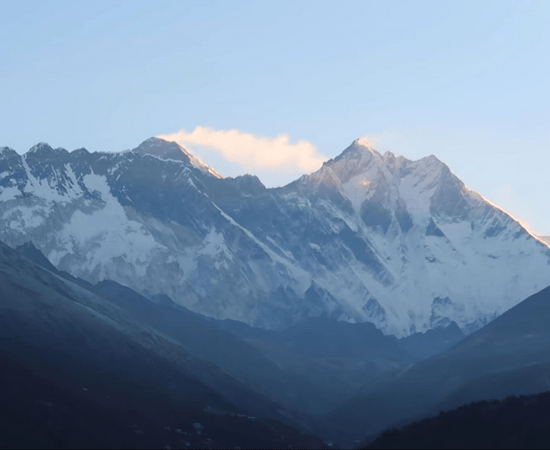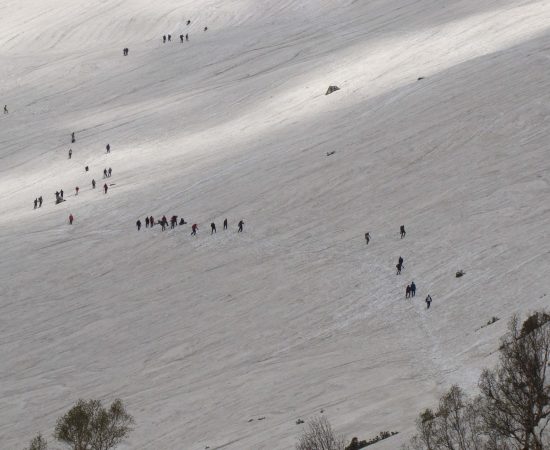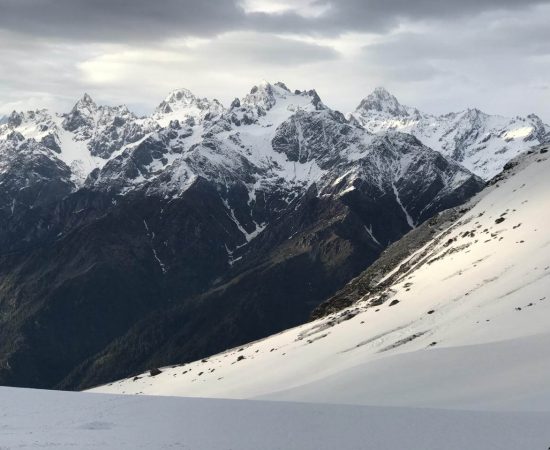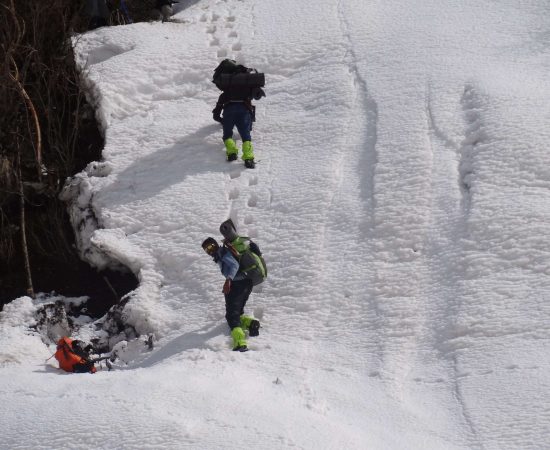Kashmir Great Lakes Trek
Sonmarg, Kashmir
Rated 4.9/5.0 on TripAdvisor. 550 Reviews


Key Highlights
- Altitude : 4175 mts
- Time : 9 Days - 8 Nights
- Region: Sonmarg
- Best Time: June-September
- Distance: 69Kms
- Grade: Moderate
Overview
Kashmir Great Lakes Trek
The Kashmir Great Lakes Trek really takes you to the enchanted paradise that the Mughal ruler Jahangir appropriately termed Jannet-e-Kashmir or Paradise on Earth. This trip brings you to the magnificent Kashmiri alpine lakes that are tucked away behind tall, snow-covered mountains close to Sonamarg. The Kashmir Great Lakes trip is unique because it includes three high-altitude crossings with elevations exceeding 13,000 feet and offers the magnificent backdrop of the stunning alpine lakes for which it is most well-known. In contrast to the more well-known locations where people throng from all over the globe to experience Kashmir's natural beauty and gracious hospitality, the Kashmir Great Lakes walk offers a far more nostalgic setting where only shepherds wander. Long expanses of lush, green grass, tall mountains, meadows, and the alpine lakes' glistening, pure water. You will ascend to a height of 4206 metres above sea level throughout the journey, which includes both climb and descent on each day. Since we don't gain much height on this journey and don't need to have technical mountaineering abilities to finish it, the difficulty level may be classified as easy to moderate. A healthy set of lungs and "heather stride" will get you through the day. However, the most challenging aspect of this trip is the 72 km that you must finish over the course of the whole journey.
Cost Per Person
Key Highlights
- Altitude : 4175 mts
- Time : 9 Days - 8 Nights
- Region: Sonmarg
- Best Time: June-September
- Distance: 69Kms
- Grade: Moderate
Complete
Itinerary of trek
We will arrive at our first campground, Shitkadi, which is just 15 kilometres from Sonamarg, after driving by road for 80 km. In the evening when you arrive at the campground, tea and snacks will be provided. The Trek Leader will then assign us our tents and give us a briefing on the dos and don'ts for the campground and the path. Additionally, some icebreaker exercises are required so that you may get to know your colleagues a little better and have a fun walk ahead of you. Before beginning the hike, eat meals and get plenty of rest. Camping in Shitkadi for the night.
After eating breakfast in the Shitkadi campground, we rise early at 6 am and go to our next campsite, Nichnai. We aim to leave as early as possible since the trek is lengthy and largely steep. For the first section of the path, we will leave the roadhead behind and begin our arduous ascent uphill towards table top, a huge grassland ringed by Gujjar huts that throng the area throughout the summer months to feed their cattle. There are also a few dhabas nearby that offer maggie, omelettes, and tea beside traditional Kashmiri views of the Thajwas glacier and Sonamarg town in the background. As we go on, we pass through the Silver Birch or Bhojpatri woods. Hindu tradition places historical weight on these trees since it was on their barks that the first written writings were composed. We go along the mountain stream's edge, stopping often to replenish our water bottles and cool down our aching feet in the chilly stream water. We will camp in the stony meadows of Nichnai today after leaving the tree line. From the Nichnai campground, take in the breathtaking sunset vista. Stay the night at Nichnai Campground.
After breakfast, we quickly start the hike and begin our climb toward Nichnai pass. The ascent begins gradually, and we cautiously cross the creek before moving on to the scree and rock-filled terrain. The hike becomes more difficult and the incline higher from this point on. Plan properly to preserve energy as the climb to the top of the pass requires a lot of both time and energy. As we ascend the pass, we are encircled by angular stony mountains covered with glaciers and moraines. We snap pictures of the surroundings from the top of the pass before starting the ascent to our campground. Once again, the scene changes from a barren, rocky area to a beautiful, multicoloured valley. Walking through these verdant meadows instantly takes you to a fantasy setting that you may have dreamed visiting. After arriving at the Vishansar campground, we'll take a break to unwind our sore muscles after the hike. Then, in the evening, we'll go to Vishansar Lake and take pictures while strolling around the lake. At our campground in Vishansar, we'll call it a night.
We keep this day free to unwind and aid our body's acclimatisation as we ascend in altitude during the hike. Use this day to take your company to the lakes Kishansar and Vishansar. And keep yourself occupied by playing various games. You could discover some local Shepherd boys playing cricket if you're fortunate. To pass the time, you may even play a game of cricket with them.
We're travelling today to Gadsar Lake, which is located at a whopping height of 4200 metres above sea level, through the Gadsar Pass. We'll start the hike by travelling the same path we used to get to Vishansar Lake. This is your last opportunity to snap pictures if you haven't already because we will be crossing Vishansar Lake again today. We will continue to hike up toward Kishansar Lake after passing Vishansar Lake. The water in this lake, which is crystal pure and changes colour as the light moves throughout the day, is equally enthralling to see. From this point on, the route becomes steep, and to carefully go to the top of the pass, we even have to gently set our feet on unstable rocks. The view is really magnificent from above. Vishansar and Kishansar, two magnificent lakes, are on one side, while Gadsar Lake and two more mountain lakes are on the other. Following the pass, the trail descends steeply for more than an hour until the valley widens into lovely meadows. We will pause at Gadsar Lake for a while to take in the scenery before continuing on to our campground. Stay the night in the Gadsar campground.
Keep your picture IDs close at hand since we will be passing an army base where security personnel will inspect them. Our journey begins with a hard elevation, and then the route flattens out into a more comfortable walking surface. Today's trail's landscape is quite different from what we've seen on our prior days of walking. In contrast to the beautiful green meadows and grasslands that we have passed on the trek the previous days, the valley is more barren and has less flora. The topography returns to the verdant, rich scenery we have been experiencing when we pass the army camp. The scenery becomes prettier as we get closer to Satsar Lake. Seven nearby lakes in the valley gave Satsar Lake its name. We continue on to our campground, where we will spend the night, after taking in the scenery of the lakes.
We shall be getting closer to Gangabal and the twin lakes Nandakol today. We begin at our campground with a little incline before beginning a sharp drop that will last for the most of our trip until we arrive at the campsite. We continue to go forward as the route leads us up, down, and then back up the mountain as it changes to match its incline. The boulder portion and loose rock on our route would be the primary challenge for us today. We arrive at Zajibal Pass, the last pass of the hike, after navigating the boulders. Spend some time relaxing and admiring the vista of Gangabal and Nandkol while perched atop the pass. We can see our campground in the distance as we come down from the Pass. Spend the night in the Gangabal campground to recharge for the last day of our hike.
Today's drive will be all downhill until we reach the Naranag roadhead, so our knees will be receiving a wonderful battering. Keep moving away from the creek and toward the ridge line as we begin our descent. On the hike, you'll be able to see Harmukh Mountain, the second-highest peak in Kashmir Valley. We may stop at one of the many tea shops we will pass along the way to rest our knees. Finally, we arrive at the road, where we will bid our trip leader, crew, and other colleagues a tearful farewell.
This day is held back only in case anything unexpected happens, like terrible weather, etc. If this day is used, you must provide the trek leader money in exchange for the usage of this additional day.
Enquiry For Group Bookings
Guidelines
➽ Preparation for Trek
As you well know, the great Himalayan trek is one that requires careful preparation, a strategy that allows for enough flexibility to adapt to whatever challenges may arise.
Therefore, here are some things to consider before setting out on your trek:
⦿ Physically – You should start working out at least a month before signing up for a program if you want to be physically prepared for the rigours of a journey. Strengthen your legs by jogging and working out regularly to increase your stamina. To better acclimatise to the environment and increase your resilience on the walk, you should give up smoking and undertake breathing exercises twice a day. Engage in vigorous physical activity, such as playing sports, doing Yoga, or running.
⦿ Mentally –
Getting in shape physically is essential, but mental preparation is just as crucial for a successful walk. Take time to enjoy your regular activities, maintain a healthy diet and sleep schedule, and unwind before embarking on a hike. Predictions regarding the journey should not cause mental worry. Spend time with your closest pals to recharge your batteries and renew your spirit. Pre-trek preconceptions are unwarranted since the first contact with the other trekkers is certain to be a source of inspiration and energy. Conditions during the walk will contribute to the increase in mental readiness. The mental repercussions of physical disadvantages will not be ignored. So, when you hike, pay attention to different regions of your body and purposefully relax them. If you want to enjoy your hike, you should learn to loosen up a little, particularly in the hips. Think about your descent as a simple dance, and enjoy the natural rhythms that the path and your body can discover together gradually, whether you're on a flowing downhill route or a frightening slope. Try out a few new walking techniques to add some fun to your commute without worrying about getting somewhere in particular. Maintaining mental fitness mostly requires a willingness to relax and take in the journey, rather than subjecting oneself to undue stress.
⦿ Technically-
Get the right size hiking boots and go for it, from a technical standpoint. You should make use of 60 litres. To become acclimated to carrying heavy items, it is recommended to utilise a backpack on a regular basis. Get a hiking stick, a water bottle, some thermal socks, a fleece or feather coat, some long pants, a poncho, some flip-flops, and any devices you may need like a camera or a power bank (DSLR or digital camera).
Guidelines
➽ Things to Carry
- Good Trekking Boots: You need sturdy trekking boots with supportive high ankles. Don't bring your running shoes. U can carry extra floaters/flip flops also.
- Wear warm clothing, such three-layer coats, fleece upper, hollow fill or down-filled jackets. Carry full-sleeved T-shirt. Carry cotton hiking trek pants and warm pant for your lower body. Never bring shorts or jeans on a hike.
- Take top and bottom thermals with you.
- Quick dry towel with light weight and Personal toiletries. Suns cream lotion, sanitizer, tooth brush ad toothpaste, lip balm and antibacterial powder.
- Socks: Bring two pairs of regular socks and two pair of wool socks for wearing at night.
- A head torch is required.
- Sunglasses/ Goggle: UV-protected sunglasses are necessary to protect against sunlight and Snow Mountain.
- There should also be a woolen cap / balaclava, cap, neck gaiter cum face mask and warm fleece and waterproof summit gloves since it will be chilly. Keep waterproof gloves on hand since they become wet in the snow.
- Everyone taking part in the activity should have their own lunchbox, spoon, mug and water bottle/ hydration pack of 2 ltr.
- Raincoats/ponchos: Since snowfall and rain are frequent at high elevations, it is important to have one on hand so as to avoid getting wet.
- Trekking bag of 75 ltr with rain cover.
- Walking stik.
- Electronics: camera (optional) USB cable/USB solar charger, charger/earphones, Power bank fully charged.
- Personal first aid box. Emergency ration, energy bars, dry fruit, electoral/Ors
- Required Documents:
a) Registration Form
b) Medical Certificate (signed by a licensed MBBS physician)
c) NOC form (completed by the trekker)
d) 2 passport-size photos
e) ID Proof photo (not PAN)
g) Insurance upto 5 lac..
Guidelines
➽ How to Reach
Everyone must go to shirnagar.
Nishant Garden in Srinagar is the designated meeting point, and Peak Rovers will handle the rest of the trip's logistics from there. Please fly in instead of taking a bus. If you want to be on the safe side, you should go to Srinagar the day before your hike starts.
Shrinagar Accessibility: Several Possible Routes
1) The Srinagar bus station is accessible from all major cities through bus. It'll take you around 30 minutes to go from the bus station to Nishant Garden.
2) It would take you 45 to 65 minutes to reach Nishant Garden by cab from Srinagar International Airport, which has connections to all major airports in India.
3) There are two different train stops:
- a) The bus ride to Jammu Railway Station is around 260 kilometres and takes about 8 hours.
- b) It takes 6 hours to reach Srinagar by bus from Udhampur, which is about 200 kilometres distant.
➽ Trip Cost Includes
- Conveyance within the journey.
- Tents that can be shared.
- Advanced and knowledgeable himalayan adventure trips guide.
- Cooks, helpers, and other necessary personnel.
- Vegetarian meals (breakfast, lunch, and dinner) along the journey
- Every organisational prerequisite for a journey
- First aid kit with portal oxygen.
- Camping fees and forest permits.
- All permissions for hiking.
- All meals will be supplied while on the hike. Freshly cooked meals will include a mix of indian, chinese, and continental cuisines.
- Lodging at a hotel, guest house, home, or in tents.
- All of the group's trekking equipment (tents at base camp, use of base camp facilities)
- All trip workers, including porters and mules for everyday items (such as food, tents, and utensils)
➽ Trip cost Excludes
- Airfare or other forms of transportation costs.
- Meals and hotel accommodations.
- Personal costs include washing, cell charging, and lodge showers
- Entry permits or permission for the inner line for foreign participants.
- Personal apparel and hiking supplies, such as liners for sleeping bags and walking sticks, are required.
- Any expenditures associated with rescue efforts or an early expedition departure.
- Guides and sherpa crew are tipped.
- Personal porters to carry hikers' packs
- Personal liability insurance or emergency evacuation costs
- Personal purchases (such as bottles of mineral water, bottled or canned drinks, chocolate, dried fruit, presents, etc.).
- From and to the trailhead, food.
- 5% goods and service tax (gst).
Guidelines
➽ Special Casual Leaves
Government employee can avail the benefit of special casual leave when u join us for a trekking expedition. As per the rule of the pay commission, special casual leave can be availed for up to 30 days in a calendar years for trekking and mountaineering expeditions through a register organization. Himalayan adventure trips are a register adventure tour operator register with Indian mountaineering foundation and Himachal Pradesh tourism. Candidates have to apply for leave at least 30 days before the trek/expedition start.
Testimonials
➽ Provided By The Customers
The trip across Kashmir was incredible because of the beautiful scenery of the valleys, mountains, and lakes (such as Gangabal, Krishnasar, and Gadsar). Our campsites, the path, and the weather were all perfect from sonamarg to naranag. We owe a great debt of gratitude to our trip leader for all of the encouragement, direction, and inspiration they Lovely and modest Kashmiri guide. The walk was beautifully and expertly orchestrated by the support crew. All of you at Himalayan Adventure Trips deserve praise for your hard work.
How useful was this post?
Click on a star to rate it!
Average rating 0 / 5. Vote count: 0
No votes so far! Be the first to rate this post.







